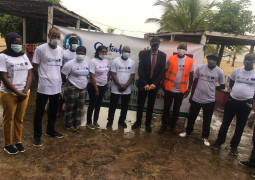
The validation comes following data analysis and compilation of the final report.
As a pre-requisite in assessing the potential nutritional impact of food fortification and biofortification programs, FAO through the European Union-FAO co-funded project titled “Improving food security and nutrition in The Gambia through Food Fortification” supported the conduct of a National Rapid Food Consumption survey, which was undertaken from 21st September to 21st October 2021.
The survey, the first of its kind was led by the National Nutrition Agency (NaNA) and supported by FAO, the Gambian Bureau of Statistics, Directorate of Health Promotion and Education, National Agriculture Research Institute, Food Safety and Quality Authority, The Medical Research Council and United Purpose.
It is aimed at providing reliable estimates of the average (daily) per capita intake of the project target food vehicles, which will help, estimate the “expected coverage” of each target crop/food consumed by the population in the project implementation area.
At the validation, Moshibudi Rampedi, FAO Representative in The Gambia said the survey was aimed at generating information on the average consumption of selected food vehicles; fruits, and vegetables among children aged 6-59 months and Women of Reproductive Age (15-49 years) in The Gambia.
She explained that scientific evidence and practical experience have shown the importance of food consumption information on policy recommendations and programming directions.
She reiterated that FAO initiated the Food Fortification and Biofortification Project to support national efforts to address micronutrient deficiencies and improve dietary diversity.
“The project supported the Government to establish the necessary regulatory and legal framework for food fortification. In line with this, the Food Fortification Regulation 2020 which mandates the fortification of wheat flour, rice, edible fats and oils as well as iodised salt was developed and launched in June 2021 by the Vice President of The Gambia. The Food Safety and Quality Authority is responsible for the enforcement of the Regulation to protect the health of the population.”
Madam Rampedi indicated that four Fortification Standards were developed and gazetted by The Gambia Standards Bureau, saying the standards are extremely important to safeguard the public from substandard food products.
To ensure that the fortification programme in the country has its desired impact, she highlighted the need for reliable information on the estimates of average (daily) per capita intake of the target food products.
“FAO wishes to renew its commitment to support the Government and the people of The Gambia under the leadership of President Adama Barrow. FAO is committed to supporting the attainment of food and nutrition security and addressing all forms of malnutrition.”
Dr. Amat Bah, the executive director of the National Nutrition Agency (NaNA), disclosed that The Gambia is experiencing the double burden of malnutrition where undernutrition including micronutrition and over-nutrition co-exist.
While undernutrition is improving, Bah noted that the current situation is still far from desired, saying that the Gambia's micronutrient survey 2018 and DHS 2019-2020 have shown that the country is making significant progress in reducing malnutrition.
He noted that there is a long way towards reaching the WHO targets, reiterating that for children under 5 years, stunting is 17.5%; wasting is 5.1%; underweight is 11.6%, and anaemia is 44.8%.
"For women of childbearing ages, anaemia is 44.3%. NaNA and partners have instituted a series of interventions to the high level of malnutrition. Some of the interventions are geared towards the treatment and prevention of micronutrient malnutrition.”
He revealed that government also adopted food fortification and biofortification as means of ensuring that people have access to and consume foods rich in micronutrients.





